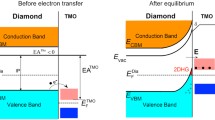Abstract.
We have investigated the mechanism underlying the surface conductivity observed for synthetic diamond(001) samples. It is found that (1) the surface conductivity depends on the pressure of the surrounding gas atmosphere, (2) the temperature dependence can be described as being due to a thermally activated process and (3) a chromogeneous WO3 cathode turns color from transparent to blue and gas bubbles develop underneath the cathode if an electrical dc current is passed through such an arrangement. In contrast, the complementary WO3 anode neither changed color nor were gas bubbles observed. One concludes that hydrogen develops at the negatively biased WO3-diamond interface, recombining to gaseous H2. However, most of the hydrogen invades the WO3 cathode coloring it blue, thereby clearly indicating the involvement of protons. Though the conductivity crucially depends on temperature, time and history of a sample, the resistances of various and even differently prepared diamond specimens covering eleven orders of magnitude can be scaled onto one master curve reflecting a thermally activated behavior. Taken together, we propose that the mechanism of the diamond(001) surface conductivity as observed under ambient conditions is at least partly due to proton conduction.
Similar content being viewed by others
Author information
Authors and Affiliations
Additional information
Received: 13 April 2000 / Accepted: 31 July 2000 / Published online: 22 November 2000
Rights and permissions
About this article
Cite this article
Koslowski, B., Strobel, S. & Ziemann, P. Are protons involved in the hydrogen-induced surface conductivity of diamond(001)? . Appl Phys A 72, 311–317 (2001). https://doi.org/10.1007/s003390000694
Issue Date:
DOI: https://doi.org/10.1007/s003390000694




